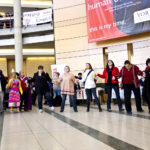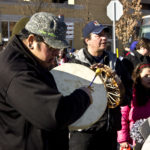On-campus demonstration consisted of a round dance followed by a teach-in
An Idle No More demonstration was held on campus January 10 by the Aboriginal Students’ Association at York as part of an Aboriginal grassroots movement spreading across the world.
The movement is an extension of the activism work concerning constitutional and treaty rights that the indigenous community has undertaken, explains Janine Manning, president of ASAY.
The on-campus demonstration, divided into two parts, included a round dance and a teach-in, giving students the opportunity to learn about Aboriginal culture and issues facing the community, like manageable healthcare, and the movement’s objections to Bill C-45.
For the round dance, a circle of people held hands, moving in a circular motion while traditional drums and hymns played in the background.
Manning says a round dance is a “display of community, unity, and solidarity.”
“In a round dance, our drums are our voices, and our dance is our demands. You can only talk for so much,” she adds.
The round dance was followed by a teach-in, led by professors Anna Zalik and Robin Cavanagh of the Faculty of Environmental Studies, who aimed to better inform students on Aboriginal issues.
Zalik, introduced as an active environmentalist and indigenous ally, spoke about how resources, such as lakes, are used, and about laws impeding indigenous rights.
“The Idle No More movement has really sparked allies in people who are settlers in this country, who have identified with the longstanding history of colonialism that hasn’t been sufficiently acknowledged,” said Zalik to the audience at the teach-in.
Cavanagh spoke about her views on the importance of the original spirit and intent of treaties made with First Nations peoples in the past.
“If the spirit and intent of the treaties was being upheld, those bills wouldn’t be there, but they are because the federal government is ignoring the responsibilities that it has to the treaties,” says Cavanagh. “It’s only by violating these treaties that they can put the policies in there and push [them] forward.”
“The Idle No More movement came to fruition because of the tyranny of the Harper majority government,” says Manning. “The last omnibus bill that was passed through, which was Bill C-45, violates Aboriginal constitutional rights.”
The Idle No More movement has a number of grievances with the bill.
The passing of Bill C-45 changes the Indian Act in such a way that when a meeting is called to propose the leasing of designated reserve lands, the decision can be made if the majority of those present at the meeting vote in the affirmative. Prior to this, the majority of eligible voters, not just those at the meeting, would have to support the decision.
The meeting can be called by the Aboriginal Affairs minister who may choose to disregard resolutions from councils of bands the land belongs to.
Idle No More protesters believe the changes make it easier for their territories to be surrendered.
Bill C-45 also changes the Navigation Protection Act so that those working to build new pipelines and power lines don’t have to prove their projects won’t harm most navigable waterways; Idle No More say the change affects 99.9 per cent of Canadian lakes and rivers.
The Act also reduces the number of new projects that require environmental assessment, a change met with disapproval from Idle No More.
“It’s an interesting time, not just for Canadian politics but for indigenous world politics. Just to say that enough is enough, ‘We will be idle no more,’ that’s not just for indigenous people — that’s for all people to prevent political apathy and any human rights violations,” says Manning.
By Hamid Adem, Assistant News Editor












